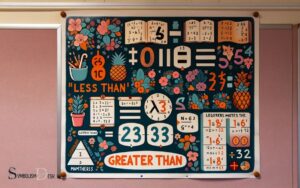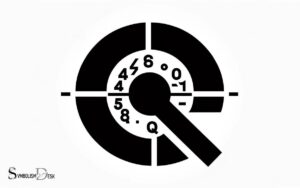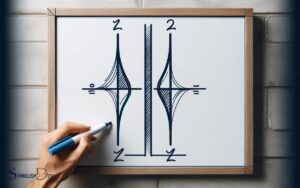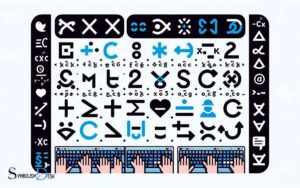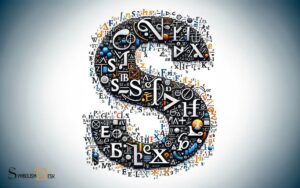Increased by Symbol in Math: Plus Sign!
The “increased by” symbol in mathematics is the plus sign (+), which indicates the operation of addition.
It is one of the four fundamental arithmetic operations and is used to signify that a number is to be added to another number. For instance, the expression “3 + 4” means that 3 is increased by 4, resulting in 7.
The plus sign (+) is a binary operator that combines two numbers, variables, or expressions to yield a single numerical result.
The operation is commutative, meaning that a + b equals b + a. In addition to basic arithmetic, the plus sign is used in more complex mathematical contexts, including algebra, calculus, and beyond.
Here’s a short example:
- 7 + 5 = 12
This indicates that 7 is increased by 5, resulting in a sum of 12. In a variable context:
- x + y
Here, x is increased by y, though the specific result depends on the values of x and y. The addition symbol holds a key role in mathematical operations, forming the basis for complex problem-solving.
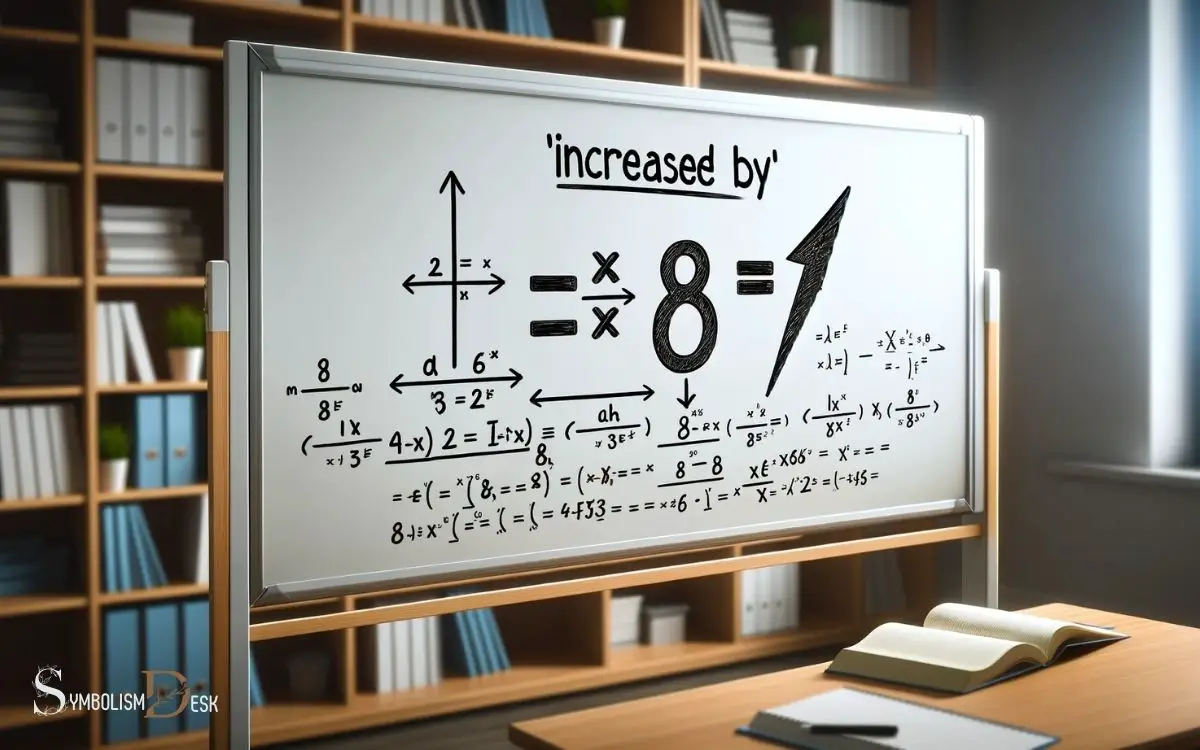
Key Takeaway
Understanding the Plus Sign (+): The Increased By Symbol in Math
| Expression | Interpretation |
|---|---|
| a + b | a increased by b |
| x + 3 | Variable x increased by 3 |
| 5 + 9 | The sum of 5 and 9 |
| n + m + p | The cumulative increase of n, m, and p |
Understanding the Increased By Symbol
How is the increased by symbol used in mathematical expressions? The increased by symbol, denoted as ‘+’, represents the operation of addition in mathematics. When the increased by symbol is included in a mathematical expression, it indicates that the value of one quantity is being added to the value of another quantity. Understanding mathematical symbols is crucial for accurately interpreting and solving mathematical equations. It is important to be familiar with the meanings and uses of symbols such as ‘+’ to effectively work with mathematical expressions.
It is used to indicate that a quantity is being added to another. For example, in the expression “5 + 3,” the increased by symbol demonstrates that 3 is being added to 5, resulting in a total of 8.
Understanding the increased by symbol is fundamental to performing basic arithmetic operations and solving mathematical problems.
It provides a clear and concise way to show the relationship between numbers when combining them.
Basic Addition Using the Symbol
Discussing the application of the increased by symbol in basic addition, where does the increased by symbol feature prominently in elementary mathematical operations?
The increased by symbol, ‘+’, is fundamental in basic addition operations. It is used to denote the combination of two or more numbers to find their total sum.
Below is a representation of how the increased by symbol is utilized in basic addition:
| Number 1 | Increased By | Number 2 | Equals | Total Sum |
|---|---|---|---|---|
| 5 | + | 3 | = | 8 |
| 10 | + | 7 | = | 17 |
| 2 | + | 9 | = | 11 |
| 15 | + | 6 | = | 21 |
| 8 | + | 4 | = | 12 |
Understanding basic addition using the increased by symbol lays the foundation for more complex mathematical concepts.
Incorporating Variables With the Symbol
The increased by symbol, ‘+’, is frequently used in elementary mathematical operations to combine numerical values and can also be extended to incorporate variables, allowing for the representation of algebraic equations.
When incorporating variables with the symbol, it’s important to understand the implications for algebraic manipulations.
Here are some key considerations:
- Variable Coefficients: The coefficient of a variable can be added to another coefficient using the increased by symbol.
- Terms with Variables: The symbol can be used to combine terms with the same variables, enabling the simplification of algebraic expressions.
- Equation Representation: By using the symbol, algebraic equations can be succinctly represented, aiding in problem-solving and analysis.
- Flexibility in Algebraic Manipulations: Incorporating variables with the symbol allows for flexibility in performing various algebraic manipulations, such as combining like terms and solving equations.
Applications in Word Problems
The application of the increased by symbol in math extends to real-life scenarios, where it aids in problem-solving and symbolic representation in equations.
By incorporating variables with the symbol, students can solve word problems that involve the concept of increase.
This practical application allows for a deeper understanding of how to use the increased by symbol to represent and solve mathematical situations.
Real-Life Math Scenarios
Real-life math scenarios often involve applying the increased by symbol to solve practical word problems.
This symbol is used to represent addition and is commonly seen in various real-world situations, such as:
- Calculating the total cost of groceries after a discount is applied
- Determining the final score of a sports game after each team’s points are added
- Estimating the amount of time it takes to travel between two cities, factoring in potential delays
- Figuring out the total distance traveled by a car after it increases its speed
Understanding how to use the increased by symbol in these scenarios can help individuals apply mathematical concepts to everyday situations.
This lays the foundation for problem-solving with symbols, which is essential for developing strong mathematical skills.
Problem-Solving With Symbols
Applying problem-solving techniques with mathematical symbols, especially the increased by symbol, is crucial for tackling real-world scenarios and developing strong mathematical proficiency.
When faced with word problems, the increased by symbol (+) is instrumental in representing situations where quantities are added together.
For instance, in a scenario where a person’s age increases by 5 years each decade, the expression “age + 5” can be used to symbolize the age after the increase.
By understanding and effectively utilizing the increased by symbol, individuals can confidently approach various real-life situations, such as finance, engineering, and science, with a solid grasp of mathematical concepts.
This practical application of mathematical symbols not only fosters critical thinking and analytical skills but also empowers individuals to solve complex problems in their everyday lives.
Symbolic Representation in Equations
Incorporating the increased by symbol into equations allows for precise representation of mathematical relationships in real-world scenarios, enhancing problem-solving capabilities.
Symbolic representation in equations offers several advantages in practical applications:
- Provides a clear framework for translating word problems into mathematical expressions.
- Enables the identification of unknown quantities and their relationships within a problem.
- Facilitates the systematic solution of complex real-life situations.
- Allows for the accurate modeling of various scenarios, aiding in the formulation of effective solutions.
Understanding the use of symbolic representation in equations is crucial for effectively tackling real-world problems in mathematics.
Comparison With Other Math Symbols
The increased by symbol in math can be compared to other math symbols in terms of its function and usage. Similar to the addition symbol (+), the increased by symbol denotes the combination of two or more values.
However, the increased by symbol specifically emphasizes the action of adding a specific value to another. In contrast, symbols like the minus (-) or the division (/) indicate subtraction and division operations, respectively.
Moreover, the increased by symbol is akin to the equality symbol (=) in that it is used in equations to express a relationship between two quantities. Understanding the distinctions between these symbols is crucial for accurately interpreting and solving mathematical expressions.
Advanced Equations With the Symbol
In mathematical problem-solving, advanced equations involving the increased by symbol are a crucial component. These equations often require a deeper understanding of mathematical principles and a strategic approach to solving complex problems.
Here are some key points to consider when dealing with advanced equations containing the increased by symbol:
- Variable Manipulation: Advanced equations may involve multiple variables and require careful manipulation to isolate the increased by terms.
- Use of Parentheses: Complex equations often necessitate the use of parentheses to clarify the order of operations when dealing with the increased by symbol.
- Application in Real-World Scenarios: Advanced equations with the increased by symbol can model real-world scenarios, such as compound interest calculations or incremental growth problems.
- Integration with Other Mathematical Concepts: These equations may require integration with other mathematical concepts, such as exponents, logarithms, or trigonometric functions.
Understanding these aspects is essential for effectively tackling advanced equations involving the increased by symbol.
Practical Exercises and Examples
In the realm of practical exercises and examples, understanding the real-world applications of symbols becomes crucial. By exploring step-by-step problem solving, we can gain a deeper grasp of how to effectively use these symbols in various mathematical scenarios.
Additionally, discussing common misconceptions surrounding symbols provides valuable insights into their proper interpretation and application.
Real-World Applications of Symbols
Real-world applications of mathematical symbols, such as the increased-by symbol, can be effectively demonstrated through practical exercises and examples. Understanding the practical use of these symbols is essential for their application in real-life scenarios.
Here are some examples that illustrate the relevance of the increased-by symbol:
- Budgeting: When creating a budget, the increased-by symbol is used to calculate the total amount when adding specific expenses or income.
- Investment: In finance, the increased-by symbol is used to calculate the total value of an investment after a certain period, taking into account the interest or growth rate.
- Engineering: Engineers use the increased-by symbol to calculate the total length or dimension of structures when additional components are introduced.
- Retail: Shop owners utilize the increased-by symbol to determine the final price of an item after applying a certain percentage increase.
Common Symbol Misconceptions
The increased-by symbol in mathematics is often subject to common misconceptions, which can be clarified through practical exercises and examples.
To address these misconceptions, it’s essential to engage in exercises and examples that provide clarity.
Here are some common misconceptions about the increased-by symbol, along with practical examples to illustrate and clarify each point:
- Misconception 1: Confusion between the increased-by symbol and the equals sign.
- Practical Example: Solve the equation “x + 5 = 10” to demonstrate the distinction.
- Misconception 2: Incorrect placement of the increased-by symbol within an equation.
- Practical Example: Evaluate “7 + x” when the value of x is 3, and discuss the significance of the symbol’s placement.
- Misconception 3: Misinterpreting the increased-by symbol as an operation to be performed.
- Practical Example: Show the difference between “3 + 4” and “3 increased by 4” to clarify the symbol’s meaning.
- Misconception 4: Failing to recognize the commutative property of the increased-by symbol.
- Practical Example: Demonstrate that “a + b” and “b + a” are equivalent, highlighting the commutative nature of the symbol.
Conclusion
The increased by symbol in math is a powerful tool for representing addition and incorporating variables in equations. Its application in word problems and comparison with other math symbols highlights its versatility and significance in mathematical expressions.
By understanding and mastering the increased by symbol, students can confidently tackle advanced equations and practical exercises, making it an essential concept to grasp in the study of mathematics.

